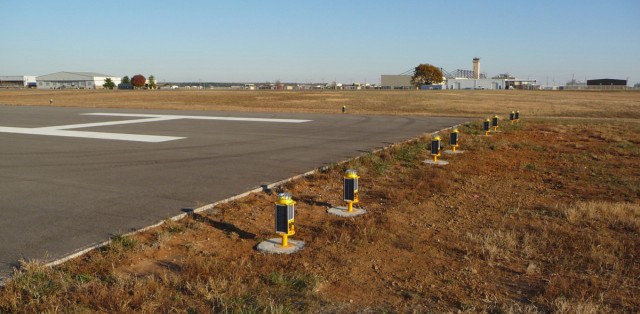Fort Campbell Army Airfield's new solar lighting system offers a state-of-the-art solution to enhance troop training and reduce power consumption at the same time.
The system enables Soldiers to train more efficiently for deployment and conserves electricity.
"We're really the first major [U.S. Army] airfield to field this system," said Larry Lutz, airfield safety officer.
Since 2002, Campbell Army Airfield has operated using a single main runway for air traffic at the installation.
When funds through the American Recovery and Reinvestment Act became available to the post for airfield improvements in late 2009, airfield officials began researching a new lighting system for Destiny Heliport and the airfield's secondary runway, Lutz said.
The installation's Directorate of Public Works Engineering Design Branch team worked with airfield officials from conceptual drawings to approval from Army Material Command to implement the new system.
The Eagle solar airfield light system, developed by the Sierra Nevada Corporation, was approved. Linc Government Services installed the system this fall.
Lutz noted that there are similar systems at Fort Bragg, N.C., and other military locations in the U.S., but Fort Campbell's system is the only one to meet Federal Aviation Administration standards.
Cost, Lutz said, was the key reason to go with a solar rather than a conventional light system. He said the cost for standard lighting would have totaled nearly $3 million because the infrastructure, including wiring, would have had to be rebuilt.
Instead, the cost totaled around $500,000 - a savings of about $2.5 million, Lutz said.
More than 130 solar Edge lights have been installed at Destiny Heliport and the secondary runway. Both airfields' lights are maintained using a single controller.
Matthew Yannayon, DPW engineer technician, said there are several environmental benefits of solar lighting at the airfield.
"They are solar powered and therefore do not require thousands of feet of wiring between lights and a constant commercial power source, which helps to reduce Fort Campbell's carbon foot print," he said. "The electrical savings will be substantial, but it goes beyond the cost of electric savings per year. Because no wiring was required, you not only save on the electricity but the maintenance cost also goes down and savings begin to compound."
Each Edge light contains its own individual solar panel and battery pack. The lights or cells and batteries, depending on how well they are used, can last up to five or six years.
"That's a pretty good lifespan," he said.
In addition to being environmentally-friendly, the system offers a more efficient home training ground for post Soldiers, Lutz said.
Among the highlights of the solar lighting system is a Solar Precision Approach Path Indicator, or PAPI, manufactured by Laser Guidance, on 18-36. The PAPI is designed to help guide pilots using visible and infrared capabilities.
Some 101st Airborne Division and Fort Campbell flight crews had already been exposed to a similar solar light system overseas in Iraq. The same system will be installed at several airfields in Afghanistan in early 2011, Lutz said.
"This system gives us a [Night Vision Device] mode, which allows the pilots to train just like they would train in theater. So, when they go to Iraq or Afghanistan this is the type of NVD stuff they would use to land with," Lutz said. "[It's] a great benefit to allow the troops to train with this ... So, the guys that are flying with this system right now will see this again...."
The system has been operational nightly since mid-November. Lutz said 159th Combat Aviation Brigade is predominately stationed at Sabre Army Heliport, but have been flying over to Destiny to look at the system.
"They're going to actually be the ones deployed with it," Lutz said. "When they get in country in Afghanistan, this system will then be fielded over there."
Lutz said the reviews from some 159th CAB pilots have been positive.
"So far, they love it," Lutz said.
Before this system, "when you're going to land at Destiny 23 ... you could never see the runway," said Lutz, a former Apache pilot who landed there himself during training exercises. "That's not a problem now, they can actually see the runway before they can ever get to it."
Lutz said the new solar lighting system at Campbell not only will benefit the Army, but also Air Force flight crews.
The solar setup at 18-36 also includes a fixed wing box-and-one system of lights, which indicates where an aircraft must land. Lutz noted that the U.S. Air Force uses this type of system to train C-130 and C-17 crews.
"The Air Force can now come here and do [Night Vision Device] compatible training," he said


Social Sharing